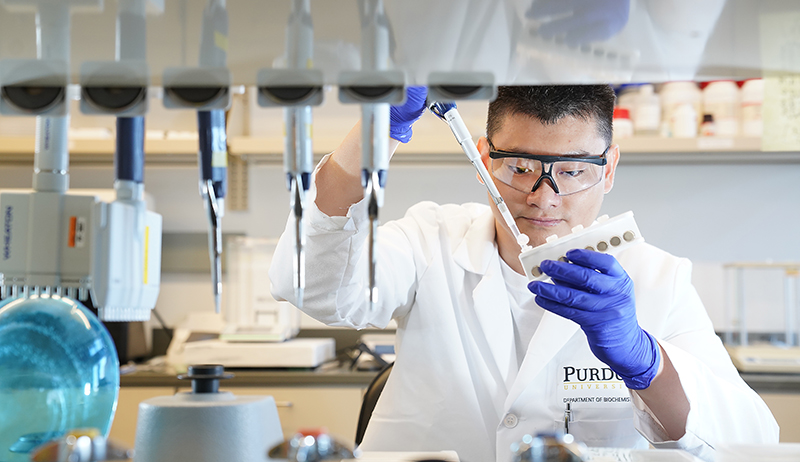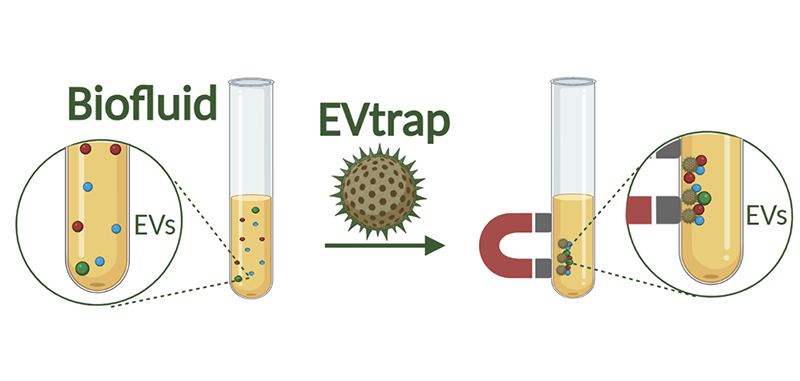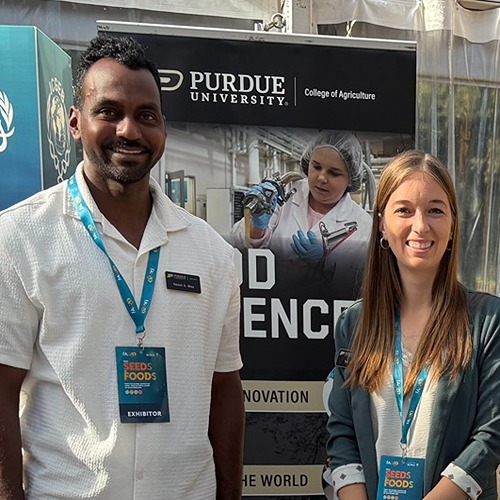New liquid biopsy method offers potential for noninvasive Parkinson’s disease testing
EVtrap technology identifies proteins from brain cells in urine samples
A team led by researchers at Purdue University and Purdue spinoff company Tymora Analytical Operations has developed a technique that may reveal signs of Parkinson’s disease in urine samples.
The technique gives researchers a chance to see if LRRK2 (leucine-rich repeat kinase 2) proteins, which are linked to Parkinson’s disease, and their downstream pathways are altered in samples from Parkinson’s patients. The method could eventually lead to widespread noninvasive testing for other neurodegenerative conditions as well as cancer.
“We believe this is a logical and rational approach to move forward for diagnosing Parkinson’s disease,” said W. Andy Tao, professor of biochemistry at Purdue. “Diagnosis for this type of neurodegenerative disease is difficult.” Cognitive and movement testing can take a year or more to confirm the diagnosis, so molecular tests for early diagnosis and intervention can help people with Parkinson’s faster, he explained.
Tao and eight co-authors from Purdue, Tymora, The Michael J. Fox Foundation for Parkinson’s Research, and Columbia University published their findings in the Communications Medicine journal.
“It’s going to be a big new area in diagnostic development,” predicted co-author Anton Iliuk, Tymora’s president and chief technology officer, “especially for neurodegenerative diseases and cancer.”
Parkinson’s disease alone affects an estimated 1% of the over-60 population. Up to a million Americans live with the disease, while 90,000 new cases are diagnosed each year.
The paper’s co-authors include Marco Hadisurya, a doctoral student in biochemistry; Kananart Kuwaranancharoen, a doctoral student in electrical and computer engineering; Xiaofeng Wu, who received his doctorate in chemistry at Purdue in 2022; Li Li, Tymora Analytical Operations; Zheng-Chi Lee, West Lafayette Junior/Senior High School; Roy Alcalay, MD, Columbia University; and Shalini Padmanabhan from The Michael J. Fox Foundation, which funded the work.
 Marco Hadisurya, a doctoral student in biochemistry at Purdue, is a co-author of a new paper in the Communications Medicine journal that describes a method that can screen urine samples for proteins linked to Parkinson’s disease.
Marco Hadisurya, a doctoral student in biochemistry at Purdue, is a co-author of a new paper in the Communications Medicine journal that describes a method that can screen urine samples for proteins linked to Parkinson’s disease. The project began several years ago after Padmanabhan read some of Iliuk and Tao’s work on the EVtrap (Extracellular Vesicles total recovery and purification) method for urinary analysis and proposed a collaboration.
“When I reviewed the data from their previous publication,” Padmanabhan said, “it was interesting to note the expression of an important Parkinson’s disease-linked protein, LRRK2. This piqued my interest since this approach provided us with an opportunity to determine if LRRK2 proteins or the downstream pathways they impact are actually altered in urinary samples from Parkinson’s patients who harbor a mutation in the gene.”
In 2017, Tao led a team that developed a blood test that could feasibly detect breast cancer. In that work, Tao and his colleagues compared samples taken from breast cancer patients and a healthy control group.
“We identified phosphorylated proteins, which are a typical hallmark of cancers,” Tao said. And within those proteins, the team found extracellular vesicles, small packages that cells use as their molecular delivery system. The finding demonstrated that a blood sample yielding phosphoproteins could serve as a potential marker for early cancer diagnosis or for monitoring disease progression.
The team was able to rapidly isolate the vesicles from urine samples, using the EVtrap method developed by Tymora.
“We have used the method for a number of indications, primarily focusing on different cancers for biomarker discovery and validation,” said Iliuk, who received his doctorate in biochemistry at Purdue in 2011. Iliuk and Tao co-founded Tymora Analytical, which specializes in technology and services for detecting disease biomarkers in biofluids.
“This kind of analysis opens a new frontier in noninvasive diagnostics development. It’s showing that biomarkers previously thought to be undetectable have become uncovered and do a really good job of differentiating disease from non-disease state,” Iliuk said. “It’s not obvious that urine would be a source of brain-based chemicals or signatures, but it is. These EVs can penetrate the blood-brain barrier quite easily.”
 The EVtrap technology uses magnetic beads to rapidly isolate and identify large quantities of proteins from extracellular vesicles, which cells use in their molecular delivery systems. (Image provided by Tymora Analytical Operations)
The EVtrap technology uses magnetic beads to rapidly isolate and identify large quantities of proteins from extracellular vesicles, which cells use in their molecular delivery systems. (Image provided by Tymora Analytical Operations) After export from the brain into the bloodstream, they become concentrated or filtered into urine. But sampling such biomarkers from the brain via spinal tap is a highly invasive procedure.
“Especially for early diagnosis that is not the preferred sampling method,” Tao said. Urine samples contain proteins that could be disease markers, but many perform housekeeping functions that are unrelated to disease.
“Extracellular vesicles provide a way to focus on disease markers because they are released by certain types of cells,” he said.
Among the many ways to study the impact of LRRK2 is to track its biological pathway, which can be done by analyzing urine, blood and cerebrospinal fluid. The EVtrap method provided an easy way to track changes in urine, which is collected for many clinical studies.
The LRRK2 Biobanking Study at Columbia University has a large bank of urine samples available for meaningful Parkinson’s disease research. Columbia University co-author Alcalay, who provided many of the samples, also helped correlate EVtrap data with the clinical data. For the Communication Medicine study, the team studied samples from people with and without the LRRK2 gene mutation, and patients with and without the disease.
Padmanabhan noted, “This study also highlighted that changes in urinary proteins could serve as a proxy for changes in protein signatures that occur in brain diseases like Parkinson’s disease.”
The study follows a 2021 paper published in the journal EMBO Molecular Medicine by an international team of researchers showing a connection between LRRK2 and brain proteins in urine samples. That study, led by Matthias Mann of Germany’s Max Planck Institute of Biochemistry, included Padmanabhan and Columbia University’s Alcalay as co-authors.





